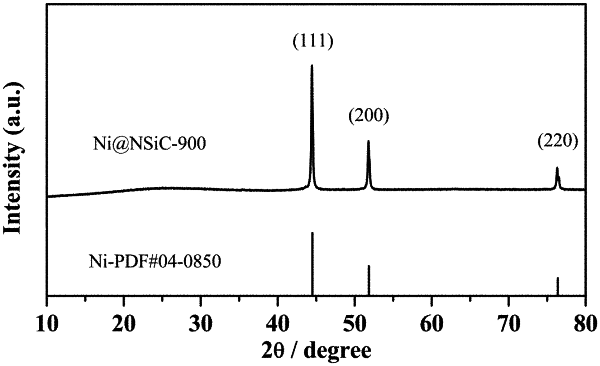| CPC G01N 27/3277 (2013.01) [G01N 27/308 (2013.01); G01N 27/3278 (2013.01); G01N 27/4163 (2013.01)] | 8 Claims |

|
1. A fabrication method of an enzyme-free glucose sensor, comprising the following specific steps:
step (1): subjecting washed and dried Magnolia grandiflora L. leaves to calcination in a high-temperature tube furnace to obtain a biochar;
step (2): soaking the biochar in hydrochloric acid, adding the hydrochloric acid-treated biochar, pyromellitic acid, nickel acetylacetonate, and N,N-dimethylformamide to a mixed solution of ethanol and ultrapure water to obtain a resulting mixture, and stirring the resulting mixture for dispersion to obtain a mixed solution A;
step (3): subjecting the mixed solution A to a reaction in a microwave synthesizer to obtain a mixed solution precursor B, wherein in the step (3), the reaction in the microwave synthesizer is conducted under the following process parameters: a microwave power: 180 W to 200 W, a reaction temperature: 160° C. to 180° C., and a reaction time: 2 h;
step (4): pouring the mixed solution precursor B into a centrifuge tube, then centrifuging and drying the mixed solution precursor B to obtain a product C;
step (5): flowing NH3 in the high-temperature tube furnace and subjecting the product C to high-temperature calcination at 900° C. for 2 h in the high-temperature tube furnace to obtain a Ni@NSiC nano-electrode composite material; and
step (6): mixing the Ni@NSiC nano-electrode composite material, water, ethanol, and a 5 wt % Nafion solution to prepare a Ni@NSiC solution, pipetting the Ni@NSiC solution with a pipette and adding dropwise onto a pretreated electrode, and air-drying the electrode to obtain a Ni@NSiC/GCE electrode,
wherein in the step (6), in the Ni@NSiC solution, the Ni@NsiC nano-electrode composite material has a concentration of 5 mg/mL, and the water, the ethanol, and the 5 wt % Nafion solution have a volume ratio of 665 μL:335 μL:25 μL; 5 μL of the Ni@NsiC solution is pipetted with the pipette; and the pretreated electrode is prepared by polishing a glassy carbon electrode (GCE) successively with 1.0 μm, 0.3 μm, and 0.05 μm Al2O3 polishing powders; rinsing the GCE with deionized water, and subjecting the GCE to ultrasonic treatment three times with deionized water and then to ultrasonic treatment once with absolute ethanol, wherein each ultrasonic treatment is conducted for no more than 30 s; and finally blow-drying the GCE with nitrogen.
|